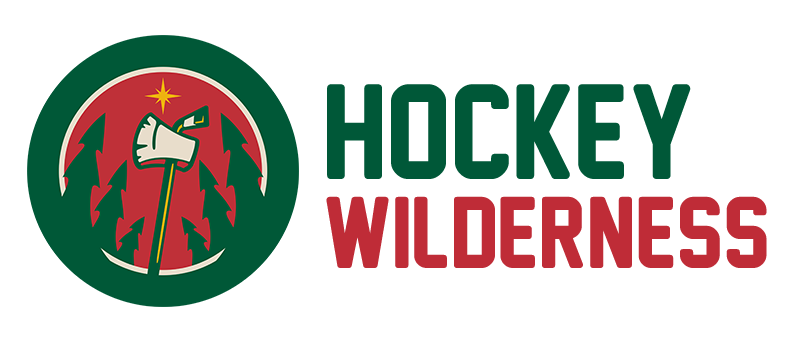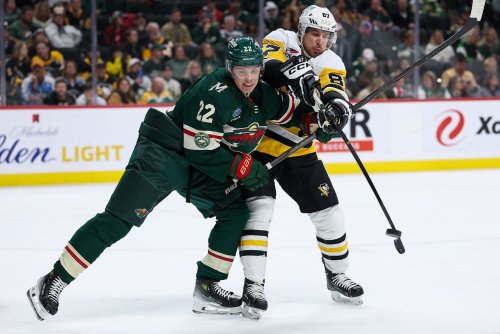
Wednesday, April 9, was unexpectedly eventful for the Minnesota Wild. Kirill Kaprizov and Joel Eriksson Ek returned. A player scored four goals for only the third time in franchise history, and Marc-Andre Fleury may have made his final home start.
An instant classic 8-7 barn-burner had Wild fans’ heads spinning.
Minnesota earned two huge points and sits alone in the top wild card spot because they have games in hand and a solid tiebreaker. Still, seven goals from the San Jose Sharks? It brings nagging doubts into fans’ heads. Is Fleury cooked? Why can’t the Wild defend? Does anything really matter?
Of course not. Nothing matters, and everything is always the same. Minnesota will likely be bounced in the first round (two-to-one odds by sportsbooks, or about a 33% chance to win a playoff round) within two weeks of this writing.
Even so, let’s try to find out just what happened.
The data initially points a finger at Fleury. 2.8 expected goals (xG) is a pretty average workload, even for a Wild team averaging 2.88 xG against (xGA) per 60 minutes (11th-best in the NHL).

But remember that when data points a finger, four fingers point back at itself. Looking through the tape of all seven goals, MoneyPuck’s xG model underscored many of these chances. The model accounts mainly for the shot type (wrist shot, deflection, backhand, etc.), shot location, and the time and location of the last event (usually a pass or turnover).
It doesn’t know if the goaltender was screened or how long the puck carrier held and skated with the puck. The model also ignores who is shooting the puck, so dangerous snipers like Will Smith and Macklin Celebrini can outperform the model over time.
On a night like this, it's possible that the xG model undersells the danger of the shots that Fleury faced. Sometimes, a goaltender can perform admirably on this amount of xG, letting in four or even five goals. But seven? That raises my eyebrows.
Still, let’s check the tape and do what Minnesota sports fans do best: assign blame.
Toffoli’s goal was indicative of San Jose’s offense all night. They had many plays from below the goal line that found half-covered snipers in the slot. At first glance, Rossi appears out of position, but he’s done his job well. He got a stick into the passing lane. However, Rossi’s reaction leaves a bit to be desired. He could have charged Toffoli’s forehand and contested the shot. Rossi is a step slow, which gives Toffoli time to pick his spot.
According to Moneypuck’s model, Toffoli only had a 7.6% chance of scoring, which would be around the 30th percentile of shot danger for all shots -- in other words, it qualifies as a “low-danger chance.” Any hockey fan could tell you this is a particularly dangerous shot, so the model probably undersells the shot danger here.
Still, Fleury might want this back. He has eyes on the puck, but his initial reaction to Toffoli’s shot is to drop his right pad to cover the five-hole. Toffoli quickly elevates the puck with a heel shot and beats Fleury below the glove.
San Jose’s second goal also featured good perimeter puck movement.
At first, I thought this was Johansson’s fault for leaving the strong-side point open. However, upon a second watch, he is “on the rail” (an imaginary line between the faceoff dots and hash marks), covering the most dangerous passing lane. In this case, that’s the weak-side defenseman. With so much puck movement, Johansson should prevent a change of side and instead give up the pass to the strong side point.
There’s not much Fleury can do on this play. He squares up for a tip from Celebrini, which leaves him out of position when the tip ends up on Celebrini’s forehand instead of on net.
Brock Faber is the culprit here. As the Wild broadcast highlighted, he chases Celebrini far from the net just before the shot attempt. It’s a habit of Faber’s that most NHL defensemen can’t get away with, but Faber does this all the time and is often rewarded with turnovers at the boards. This is a “better-be” play, as in you better be right. Celebrini turns back to the net with elite edge work and timing, wide open in the slot.
Faber also decides to chase with Brodin at the net front, who could normally help in this situation. However, Nikolai Kovalenko’s smart play pulls Brodin from the slot.
Grundstrom’s goal was not quite as pretty.
The first issue with this play is Bogosian and Boldy’s rush defense. Defending Grundstrom two-on-one with help from Merrill and Foligno, neither steps up to make a play. On top of that,
Bogosian fails to follow Grundstrom to the net.
Boxing out Grundstrom to the side could have prevented him from tapping in this leaky puck. I don’t fault Bogosian for failing to clear this puck, as it’s stuck on his backhand; however, that highlights that he should be boxing out Grundstrom instead of standing behind Fleury.
Speaking of Fleury, his sins on this goal are worse than Bogosian’s or Boldy’s. Cam Lund’s point shot had a 2.3% xG value. That doesn’t account for the chance of a rebound or tip, increasing the danger of the chance, which Fleury does by failing to catch the puck. It appears that Lund made a small angle change on his way in, which Fleury tracked reasonably well, sliding right to left.
Still, Fleury should have frozen this puck. Lund’s hardest shot this season was 83 mph, about league average for a forward but well below the average for a defenseman (about 90 mph). Shots from the point should be frozen when they come that slowly.
Enough of the greasy goals. Back to the good stuff.
Well, kind of. I give Fleury a pass on this knuckler puck. The xG value of 5.3% implies that Fleury should save shots from this spot about 95% of the time. However, this is an opportunity to consider xG in another light. An average NHL goalie would save about 95% of shots from this area on a pass below the goal line. Still, the strange shot angle makes this one of the 5% goalies should be okay with letting in.
Celebrini doesn’t make full contact with the puck, which actually works to his advantage. This one is like a chip shot in soccer. If hockey players could reliably pull this shot off, you could question Fleury’s technique. Since they can’t, Fleury does everything right by squaring up to the shooter and coming out of the net.
The defensive breakdown is another example of the Sharks working the puck from the perimeter into the slot. Gaudreau steps up to Celebrini far outside the faceoff circle, and Celebrini works a blazing give-and-go play to beat Gaudreau to the net.
Gaudreau may be anticipating help from Brodin, but he’s actually unavailable when the puck is behind Minnesota’s net. As diagrammed in Jack Han's Hockey Tactics 2025, The Wild like to use both defensemen to trap opposing puck carriers in this area of the ice, and Brodin anticipates that Smith will try to carry the puck around the net.

Brodin ends up with the net between himself and Celebrini, unable to cover for Gaudreau.
The next rep is another Marco Rossi near miss.
Like the Toffoli goal, Rossi is the nearest to the goal scorer, so he’ll get all the ugly Twitter screenshots. However, the blame lies with Zuccarello and Kaprizov on this goal.
Zuccarello starts this play with a turnover inside San Jose’s blue line. Rather than forcing a pass through two Sharks to a covered Kaprizov, he could have played the puck to Rossi on the half wall or Chisholm at the point. That would have established possession and prevented a counterattack.
Rossi is the deepest man in San Jose’s zone, so he has few responsibilities in this situation. Kaprizov and Zuccarello track back appropriately, but Kaprizov makes a mistake in the defensive zone.

At this moment, Kaprizov should be covering the passing lane from below the goal line across the net, as Johansson did on San Jose’s second goal. Instead, his focus is on returning to the right wing point. It’s not an unforgivable mistake, but it’s why this passing lane is open. Essentially, Kaprizov hands off that responsibility before Rossi can cover that passing lane.
Why is Rossi unable to cover that passing lane? All because of the Zuccarello turnover, in which Rossi was available at the half-wall in San Jose’s zone. Zuccarello and Kaprizov are excellent offensively and reasonably good two-way players but plays like this are the trade-off.
Fleury has no fault in this goal. It’s a wide-open chance in the slot changing sides, then skating away from the grain. The xG value of 14.5% undersells the danger because Fleury is screened, and the Wild aren’t pressuring the shooter. On top of that, the quality of the shot (perfectly placed on the far side top corner) makes it far more difficult to save than an average shot from this location.
This was when Celebrini and Smith took this game from good to great. Maybe the future really is teal.
Maybe this is a hot take, but I can’t find fault with a single player here. The forecheck forces a contested pass to the point, and the tip pass would be icing if not for Smith’s speed. Bogosian contests Smith behind the net with several stick checks, but Smith protects the puck with his body.
Eriksson Ek has his man covered off the rush and tries to keep his right skate in the passing lane as he turns from rush defense to in-zone defense. He nearly swats the pass away with his stick. Fleury protects the wraparound but can’t do that, nor can he get across the net fast enough or contest the passing lane with his stick.
When another team strings together that many passes under constant pressure, there’s nothing more to be done. If you want to assign blame, it’s just that Bogosian is no longer fast enough to defend in space when elite players get these types of chances.
This one was about the Jimmies and Joes, not the X’s and O’s. Tip your cap to San Jose’s young players on this.
The same can’t be said of the game-tying six-on-five goal.
When Celebrini first receives the puck at the left point, Minnesota’s coverage is correct. Boldy drops from his weak-side responsibilities to cover the slot but remains there too long after Gaudreau has recovered.
When the puck moves to Liljegren at the center point, Boldy should respond by stepping to Liljegren and Smith’s double-attack, but he leaves both players essentially uncovered. Because Boldy stays in the high slot for too long, it opens space in the faceoff circle for Smith to take a medium-danger shot.
To win in the playoffs, the Wild will need better five-on-six defense from Boldy.
Fleury is not blameless on this goal. He reacts to the shot late, and that’s enough on a shot inside the bar. Fleury seems distracted or screened by Eklund tripping in front of him, but there’s not much more Bogosian can do to box out Eklund. He even hooks him to slow his path into Fleury’s eyes. If anything, Bogosian is overzealous. He could have ended up with a tripping penalty if Smith didn’t score immediately after the trip.
As good of a shot as Smith takes from a medium-danger area, Fleury could probably be expected to do more on this shot. Still, it’s not the worst goal to give up.
So there you have it. Weigh this information however you take it. With seven goals against, there was plenty of blame to go around.
From a ten thousand-foot view, the only repeatable aspect of this game seems to be Fleury’s performance. Not every goal was his fault, but this game solidifies him as a clear backup rather than the 1B to Gustavsson’s 1A. The Wild likely won’t put him in net for the playoffs unless a deep run necessitates a game of rest for Fleury’s Swedish colleague.
The Sharks also victimized Bogosian’s skating on more than one occasion. But, with his minutes already sheltered, there’s nothing more that Minnesota can do to mitigate that problem.
For the rest of the team, this is the bad you take with the good. Rossi had some bad puck luck. Kaprizov and Zuccarello take some calculated risks every game, and San Jose’s top line bit them on those risks last night. Faber’s on-ice results speak for themselves throughout the season. He shouldn’t change his game just because perhaps the best young player in the game victimized his aggressive defense.
Ultimately, the Wild seem to have solutions in place for the issues they had against the Sharks. Don’t let this game temper playoff expectations, even if their first-round opponent is a two-to-one favorite.
Think you could write a story like this? Hockey Wilderness wants you to develop your voice, find an audience, and we'll pay you to do it. Just fill out this form.
-
 2
2
-
 4
4







Recommended Comments
Join the conversation
You can post now and register later. If you have an account, sign in now to post with your account.
Note: Your post will require moderator approval before it will be visible.